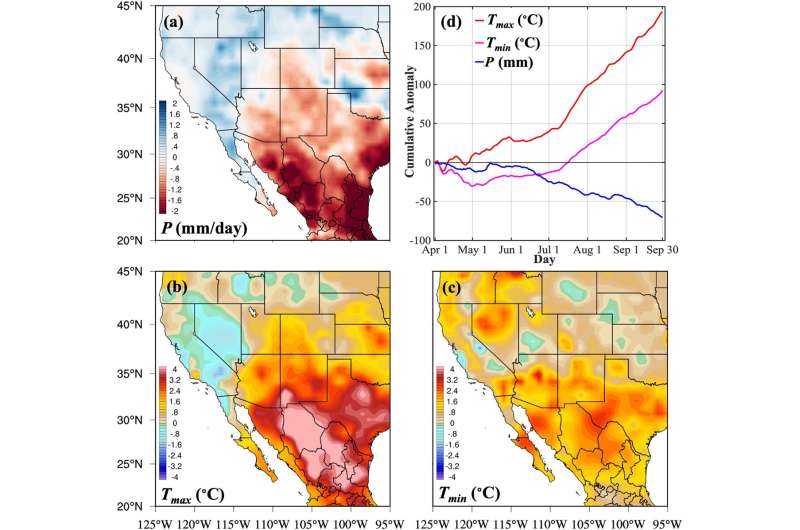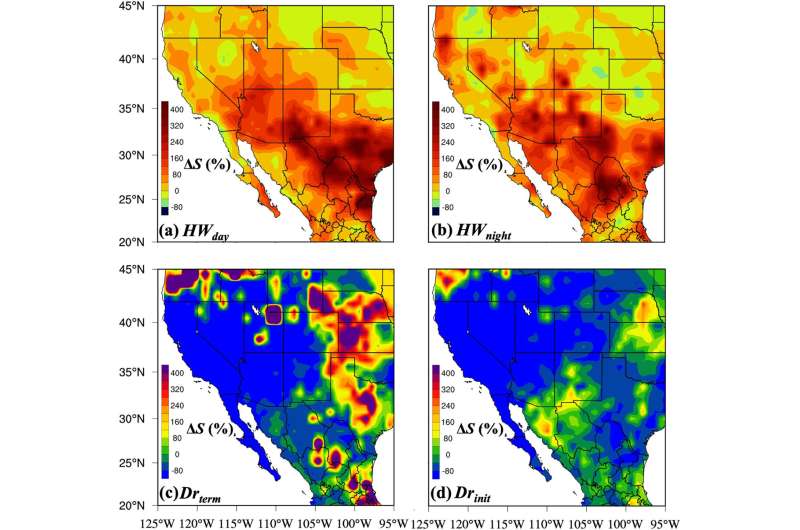By Sean Cummings

Dry soils in northern Mexico may trigger episodes of simultaneous drought and heat wave hundreds of miles away in the southwestern United States, such as Arizona, New Mexico, and Texas, according to a new study. These "hot droughts" in the region increasingly persist through consecutive days and nights rather than easing up after sundown, the research also found, leaving no window for afflicted areas to recover.
Hot drought can kill crops, worsen wildfire risk, and shock workers and outdoor enthusiasts with unexpectedly high temperatures, all more than either drought or heat alone can do. Scientists involved in the study say the findings could help communities better anticipate and prepare for these stressful events in advance, such as by limiting outdoor working hours, keeping medically vulnerable individuals inside, and opening cooling centers when soils far upwind desiccate.
The study appears in Geophysical Research Letters.
"Hot droughts will propagate to other parts of the country and have detrimental effects on health, on infrastructure, on daily life," said Enrique Vivoni, a hydrologist at Arizona State University and senior author on the study. As climate change continues, the authors said, more places will likely experience the dry soil conditions that spur and spread hot drought. "We need systems to alert us to hot drought just like we have systems that alert us to hurricanes."
In summer 2023, Southwestern North America weathered an unusually intense hot drought. Using temperature records, rain gauge readings, and a soil moisture dataset from satellite and ground-based measurements, Vivoni and Somnath Mondal, a hydroclimatologist at Northeastern University, set out to characterize the event in the context of previous hot droughts and identify the conditions that set the stage.
For this study, they defined hot drought as any period when at least two weeks of abnormally low rainfall overlapped with at least three straight days of unusually high temperatures.
Even ordinary summers in the region can get brutal, with daytime temperatures since 1980 typically sitting at around 35 to 40 degrees Celsius (95 to 104 degrees Fahrenheit) in some locations. But 2023's hot drought, the duo found, cranked up the heat by as much as 8 degrees Celsius (14 degrees Fahrenheit).
This resulted primarily from weather patterns that suppressed the transfer of atmospheric moisture from the Pacific Ocean into the North American Monsoon, which from July to September typically provides 40 to 80% of the region's annual rainfall. The weak monsoon exacerbated the drought already gripping the U.S. Southwest and Northern Mexico at the time.
"Lack of rainfall can increase heat, which can further intensify the loss of water," noted Mondal. Soil heats up and releases heat more readily when dry, since more of the sun's energy is spent warming the air and earth rather than evaporating soil moisture.
All told, the event reached nearly five times the severity of average hot drought conditions in the region over the past four decades.

Click here to see more...